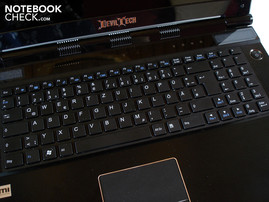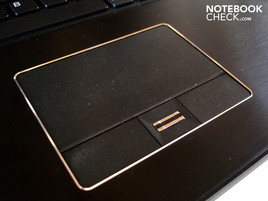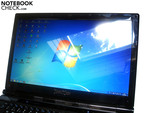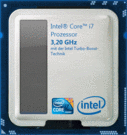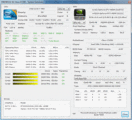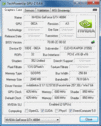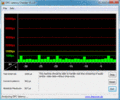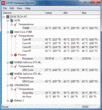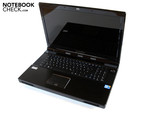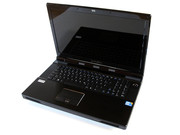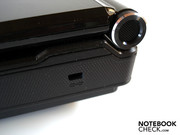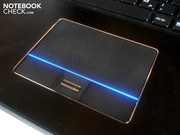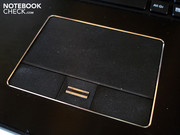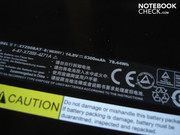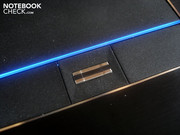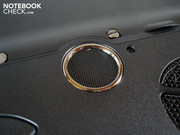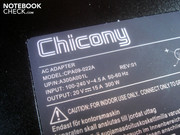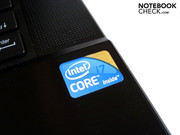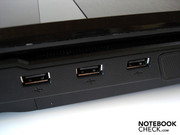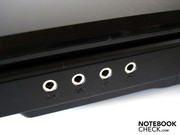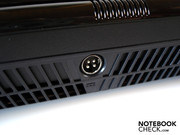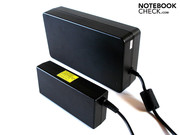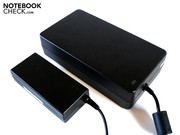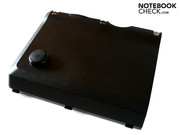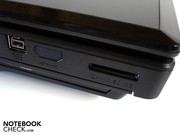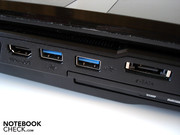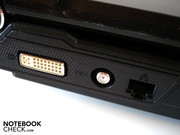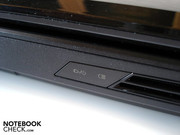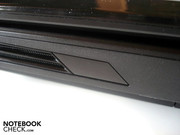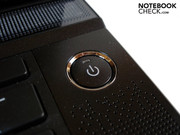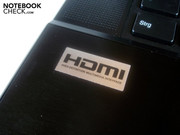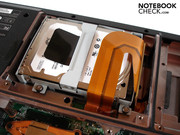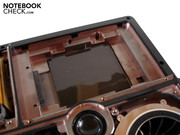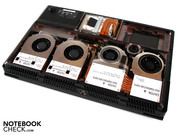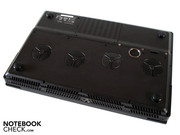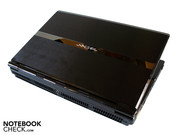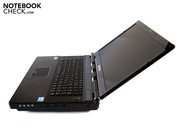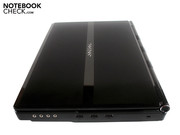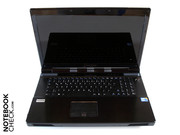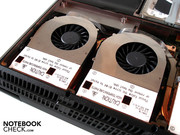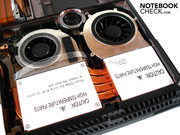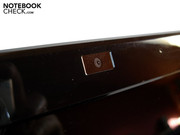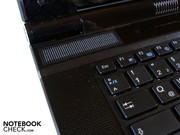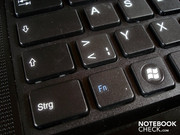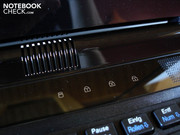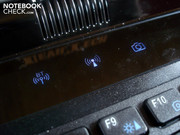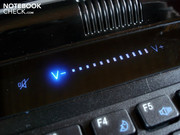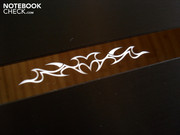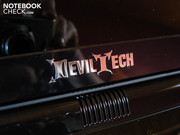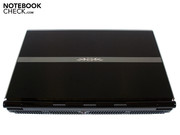Review Deviltech HellMachine DTX (Clevo X7200) Notebook
Clevo's barebone, X7200, is the basis of the HellMachine DTX. It is still being distributed by many other manufactures, like mySN and CyberSytem, beside DevilTech.
The 17 inch desktop replacement can be modified to suit your individual preferences on DevilTech's website. It starts with the operating system, where you can choose among several alternatives amid Windows 7 Home Premium, Professional and Ultimate (32 & 64 bit). Strangely enough, not a mobile CPU, but a desktop model from Intel's current i7 range is used as the processor. They range from Core i7-950 with 3.06 GHz up to Core i7-980X with 3.33 GHz.
Nvidia's GeForce GTX 460M takes care of graphic calculations in the basic version. It has already proven its capabilities in the review of the Asus G73JW. However, it is also possible to configure it with a GeForce GTX 480M or a SLI configuration of two GeForce GTX 460Ms for a surcharge. Beyond that, DevilTech offers downright aficionados the possibility of two GeForce GTX 480Ms. However, that costs a pretty penny of over 1000 euro.
Another highlight of the HellMachine DTX is the option to install up to three hard disks. Aside standard HDDs with a capacity of 250-650 GB (5400 & 7200 rpm), DevilTech also has SSDs with a capacity of 80-250 GB in its range. Furthermore, the customer has the option of extending the DDR3 RAM from the standard two GBs up to 12 GBs, so the memory won't get tight. DevilTech also has the suitable hardware in store for movie fans. If a common DVD burner isn't enough, you can simply reach for a Blu-Ray drive or a Blu-Ray burner.
DevilTech has set a price of 1699 euro for its HellMachine DTX. But the price can quickly multiply itself with the according configuration. Our test device with a Core i7-960, GeForce GTX 480M SLI, four GB of DDR3 RAM, 320 GB HDD (7200 rpm), DVD burner and Windows 7 Home Premium 64 bit, for example, added up to 3454 euro at the time of the test.
Case
In our opinion, the X7200 barebone has soonest earned the name "behemoth". The 17 incher isn't only extremely heavy and thus unhandy to carry around with a weight of almost six kilograms. It is also utmost bulky with a height of about seven centimeters. When the notebook is placed on a normal desk or table, the hands are placed in an uncomfortable angle for use. Optimal ergonomics is hardly possible.
Apart from the one or other lighting element, the manufacturer has rather shown restraint in terms of looks. Construction and design are both just as classic as the colors dark. Clevo has used a blend of several materials for the components. Whilst the display lid and wrist-rest are made of high-end, brushed aluminum, the other surfaces are (partly high-gloss) plastic. The workmanship is nevertheless on a high level. We didn't notice any flaws on our test device, apart from small details.
The case doesn't have to accept reproach in view of stability, either. Notebook upper side and bottom prove to be very rigid. Merely the display lid could have shown a bit more stiffness. The basically reliable hinges appear to be pulled a bit tight. Despite its enormous weight, the base unit lifts slightly when the notebook is opened.
Configuration and Supplies
Connectivity
The very extensive connectivity is absolutely astonishing. With exception of an ExpressCard slot and a VGA-out, Clevo has incorporated every imaginable interface that you can expect of a full-fledged desktop replacement. Whilst the front is completely free of any connections and the rear only accommodated the power jack, the sides are equipped lavishly. Thus, the right can't only serve with a Kensington Lock and three USB 2.0 ports. It also has four audio connections that are able to transmit a 7.1 surround signal.
On the left, there are two digital video outs in form of DVI and HDMI. The use of an external monitor is thus no problem. An RJ-45 Gigabit LAN port, an antenna-in and port for eSATA and Firewire are other connectivity features. To be adequately prepared for the future, the X7200 barebone additionally has two advanced USB 3.0 ports. They can score with a higher transfer rate. Otherwise, data from memory cards can be fed with assistance of a 9-in-1 cardreader. The configuration bundle is finished off by a fingerprint reader, a 3.0 megapixel webcam and even two integrated microphones.
On the whole, we quite liked the port distribution. The most important connections are located on the rear side areas. Thus, there's enough elbowroom for peripherals, such as mice, on the notebook's sides.
Software and Supplies
In terms of software installation, DevilTech shows itself pleasantly restrained in comparison to "big" manufacturers like Toshiba, Sony, Acer or Asus. Thus, the system isn't seized by superfluous software (so-called Bloatware) that narrows the system speed, as so often common in this industry. Due to the clean installation, the HellMachine DTX can develop its full performance potential from the first second.
The scope of supplies isn't necessarily lavish, but at least decent. Apart from the very voluminous 300 watt adapter, DevilTech has added a driver DVD, a user's manual and a cleaning cloth in the box. Those who additionally install a TV tuner (cable & DVBT) for a surcharge, also get a remote control.
Input Devices
Keyboard
Apart from the quite loud and clattery typing noise, the keyboard makes a very good impression. The detached keys are perfectly sized (15x15mm) and can also convince with their well-defined pressure point, as well as stroke. The typing feel can be described as crisp. The fairly long stroke length will rather be a matter of taste. In any case, the tester quite liked it. The user naturally doesn't have to live without a separate number pad due to the 17 inch size. There's nothing to complain about in terms of layout. You manage wonderfully in no time. Good for our foreign readers: DevilTech also offers the keyboard in different language layouts (e.g. English, French & Italian). The keyboard regrettably isn't lighted.
Touchpad
The 90 x 50 mm sized, silver bordered and slightly submerged touchpad is easy to locate. The somewhat corrugated surface enhances the feedback, but skin feel and gliding traits are affected. The touchpad didn't show any irregularities in terms of precision. Gamers will also be delighted about the fact that the touchpad isn't flush below the space bar, but is shifted slightly to the right. This way, input errors are reduced in gaming. If you don't want to risk anything, you'll disable the touchpad via the FN+F1 key combination. We found the trigger noise of both touchpad keys to be very loud.
Display
The X7200 barebone is equipped with a 17.3 inch and 43.90 cm sized FullHD display. The resolution of 1920x1080 provides sufficient display surface for working comfortably with several windows. Additionally, the typical movies bars are reduced due to the aspect ratio of 16:9.
| |||||||||||||||||||||||||
Brightness Distribution: 84 %
Center on Battery: 138.9 cd/m²
Contrast: 1158:1 (Black: 0.12 cd/m²)
The installed Hannstar HSD173PUW1 isn't a stranger. It has already convinced with a high image quality in other high-end notebooks (e.g. Asus G73JH). Dark image areas don't drift into gray due to the agreeably low black value of 0.12 cd/m2. This would be annoying especially in movies and games and is unfortunately the case in the majority of competitor products. Black really stays black. The contrast of 1158:1 is also on an excellent level. Colors appear very vivid and natural. Gradations and transitions prove to be very differentiated. Merely the average brightness of 153.6 cd/m2 is disappointing. The image lacks luminosity. Note: The Hannstar HSD173PUW1 partly proved to have a noticeably higher luminosity of about 183 cd/m2. This circumstance can be attributed to production quality fluctuations.
Regardless of size and weight, the desktop replacement is hardly suitable for outdoor use. The reason is the glossy display surface, which has a tendency to intense reflections in according light incidence. Because annoying reflections can also turn up indoors, you should either carefully consider the position or darken the room to start with.
Then again, the fairly high viewing angle stability is a strength of the display. There are hardly any changes even in larger angles on the horizontal plane. Color and brightness falsifications may turn up earlier on the vertical plane, but the viewing angle stability is basically still above average.
Performance
Processor: Core i7-960
As mentioned in the beginning, a real desktop CPU is used as the processor instead of a mobile one. We opted for the Core i7-960 in our test device. It clocks exactly twice as high as the popular (mobile) quad-core, Core i7-720QM with 3.2 GHz. The clock rate is even increased to 3.46 GHz when required with the automatic overclocking function, Turbo Boost. On the other hand, hyper-threading provides for the simulation of four additional CPU cores. However, the possibility of processing eight threads simultaneously only supplies extreme benefits in modified applications. Games hardly have a benefit of this technology at the moment.
The L3 cache is more crucial for gaming performance. It is more than abundant with eight MB and correlates to the fastest mobile quad-core, Core i7-940XM. A big drawback of the desktop CPU is the exorbitant power consumption of 130 watts, in comparison to notebooks. The mobile Core i7 processors are significantly weaker because of their considerably lower clock rate. However, the power requirement plays in another league with 45-55 watts.
Graphics card(s): GeForce GTX 480M SLI
Without a doubt, the absolute highlight of the HellMachine DTX is found under the hood. It's the currently fastest graphics card configuration with a SLI configuration of two GeForce GTX 480Ms. The specifications of both GPUs look impressive. With 352 unified shaders, three billion transistors and a 2048 MB sized GDDR5 video memory tethered to 256 bit each, they partly exceed the competition evidently (e.g. Radeon HD 5870).
The clock rates are rather inconspicuous, located at 425 MHz for the core, 1200 MHz for the memory and 850 MHz for the shaders. The GeForce GTX 480 pulls out all the stops in terms of features. Thus, the Nvidia card supports CUDA (conceived for general calculations), PhysX (GPU based physics acceleration) and PureVideo HD (decoded HD material), aside from DirectX 11. However, the GeForce GTX 48ßM SLI combo, like the processor, has to struggle with an extremely high power consumption (200 watts maximum).
Another central problem of SLI is the so-called "micro-jitters". The single pictures are calculated alternately by the graphics cards with the currently used technology. Because the intervals between the pictures vary quite a bit, noticeable jitters can especially turn up in ranges below 30 fps. But, micro-jitters are usually not an issue due to the high raw performance of both GeForce GTX 480M cards.
CPU Performance
The Core i7-960's outstanding application performance becomes evident in Cinebench R10 (64 bit), amongst others. The Core i7-960 can set itself off by a whole 30% from the popular Core i7-720QM in single-core rendering with 4825 to 3698 points. Even greater differences come to light in multi-core rendering. The Core i7-960 exceeds the Core i7-720QM by a remarkable 84% with 18331 to 9971 points. This is due to the twice as high clock rate (Turbo Mode remains inactive when all cores are loaded).
| PCMark Vantage Result | 6974 points | |
Help | ||
GPU Performance
As we released both GeForce GTX 480M onto our benchmark course, one thing quickly became evident: The HellMachine DTX is the strongest notebook that we ever have had in review. As you will see in further course of this editorial, the 17 inch desktop replacement has surpassed almost all our previous reference rates.
The best example: The two GeForce GTX 480M can claim an outstanding GPU score of 14890 points in 3DMark Vantage. Thus, the SLI configuration calculates a whole 86% faster than a single GeForce GTX 480M, which still achieves 7986 points (Clevo D901F). Even a GeForce GTX 285M SLI configuration can't keep up with that. It has to admit defeat by about 42% with 10511 points (mySN XMG8.c). The HellMachine DTX performs just as well in the Unigine Heaven 2.1 benchmark, which makes massive use of tessellation (a core feature of DirectX 11). A single GeForce GTX 480M in high details and a resolution of 1280x1024 is surpassed by a remarkable 74% with 58.8 to 33.7 fps.
Note: We regrettably can't present the 3DMark 01, 05 and 06 results because the notebook produced graphics errors while starting and crashed in each one. We presume it's a software incompatibility.
| 3DMark 06 Standard Score | 20144 points | |
| 3DMark Vantage P Result | 15839 points | |
Help | ||
HDD Performance
As mentioned, up to three hard disks can be accommodated inside of the HellMachine DTX's. Our test device was equipped with a 320 GB HDD named ST9320423AS from Seagate and rotates with a fast 7200 rpm. We could measure an access rate of 15.5 ms and average transfer rate of 86.5 MB/s with the tool, HD Tune. Both are relatively good rates. DevilTech has waived on an extensive partitioning. It relies on a single partition.
Application Performance Verdict
The HellMachine is one of the few notebooks found on the market that can throughout compete with full-fledged desktop systems. Core i7-960 and GeForce 480M SLI bid such a high performance that even the most demanding applications don't present a problem. The buyer is definitely well served for in the coming years with such a strong bundle. And in case the memory capacity eventually starts to run out: There's nothing standing in the way of a future upgrade thanks to three hard disk slots.
The GeForce GTX 480M SLI combo had to compete against both a single GeForce GTX 480M (Clevo D901F & DevilTech Fragbook DTX) as well as a SLI configuration of two GeForce GTX 285Ms (mySN XMG8.c) in the gaming benchmarks. We will only deal with the results in the FullHD resolution of 1029x1080 in the text, because the CPU's impact is the lowest here.
Mafia 2
The GeForce GTX 480M easily copes with the heavily laden gangster epic even in high details and 16x AF (anisotropic filtering) in its integrated benchmark. Moreover, it's able to provide a smooth frame rate of 40.9 fps. Nevertheless, a SLI combination can compute almost twice as fast with 75.8 fps.
| Mafia 2 | |||
| Resolution | Settings | Value | |
| 1920x1080 | high, 0xAA, 16xAF | 75.8 fps | |
| 1360x768 | high, 0xAA, 16xAF | 105.8 fps | |
| 1024x768 | medium, 0xAA, 8xAF | 113.2 fps | |
| 800x600 | low, 0xAA, 0xAF | 124.7 fps | |
Starcraft 2
The new reference for strategy from the developer forge, Blizzard, doesn't provoke anything but a tired smile from the high-end graphics cards. Whilst a single GeForce GTX 480M can claim 36.8 fps in very high details, the performance only climbs slightly in SLI mode to 42.5 fps.
| StarCraft 2 | |||
| Resolution | Settings | Value | |
| 1920x1080 | ultra | 42.5 fps | |
| 1360x768 | high | 64.6 fps | |
| 1360x768 | medium | 74.9 fps | |
| 1024x768 | low | 279.6 fps | |
Metro 2033
The well made first-person shooter, Metro 2033, is the only title in our overview that can bring the HellMachine DTX to its limits. Thus, its only enough for 23.1 fps in very high details, AAA (analytical antialiasing), 4x AF and DirectX 11 mode. Metro 2033 nevertheless still runs significantly smoother than it is the case with one single GeForce GTX 480M (11.8 fps).
| Metro 2033 | |||
| Resolution | Settings | Value | |
| 1920x1080 | Very High DX11, AAA, 4xAF | 23.1 fps | |
| 1600x900 | High DX10, AAA, 4xAF | 61.1 fps | |
| 1360x768 | Normal DX10, AAA, 4xAF | 106.8 fps | |
| 800x600 | Low DX9, AAA, 4xAF | 134.4 fps | |
Shift
Need for Speed: Shift can be adequately enjoyed even in high details and 4x AA due to its moderate hardware requirements. The HellMachine's SLI combo achieves an average frame rate of 93.0 fps. Thus, it places itself before the GeForce GTX 285M SLI by 17% (79.8 fps) and the GeForce GTX 480M by 80% (51.8 fps).
| Need for Speed Shift | |||
| Resolution | Settings | Value | |
| 1920x1080 | all on/high, 4xAA, triliniarAF | 93 fps | |
| 1366x768 | all on/high, 4xAA, triliniarAF | 115.9 fps | |
| 1024x768 | all on/med, 2xAA, triliniarAF | 113.8 fps | |
Bad Company 2
Those who don't want to waive on high graphics quality in the tactically demanding multi-player battles of the latest Battlefield sprout, will find the HellMachine DTX just right. We could determine a respectable 64.7 fps in the single-player intro mission with high details, 4x AA and 8x AF. Bad Company 2 runs noticeably slower on a single GeForce GTX 480M, but still moves within a playable range with 37.5 fps. Two GeForce GTX 285Ms place themselves exactly in between with 50.6 fps.
| Battlefield: Bad Company 2 | |||
| Resolution | Settings | Value | |
| 1920x1080 | high, HBAO on, 4xAA, 8xAF | 64.7 fps | |
| 1366x768 | high, HBAO on, 1xAA, 4xAF | 110.6 fps | |
| 1366x768 | medium, HBAO off, 1xAA, 1xAF | 134.4 fps | |
| 1024x768 | low, HBAO off, 1xAA, 1xAF | 151.6 fps | |
Risen
The unofficial gothic successor doesn't present the HellMachine DTX with any problems whatsoever. You can ramble through the open gaming world smoothly in high details and 4x AF with 70.9 fps. Whilst the two GeForce GTX 285M can still keep up fairly well (58.0 fps), the single GeForce GTX 480M has to be content with 35.9 fps.
| Risen | |||
| Resolution | Settings | Value | |
| 1920x1080 | high/all on, 0xAA, 4xAF | 70.9 fps | |
| 1366x768 | all on/high, 4xAF | 104.6 fps | |
| 1024x768 | all on/med, 2xAF | 125.7 fps | |
| 800x600 | all off/low, 0xAF | 148.9 fps | |
Modern Warfare 2
In opposition to other current first-person shooters, Modern Warfare 2 is relatively modest in terms of resource requirements. So, it's not really a wonder that two GeForce GTX 480Ms can present an extremely smooth frame rate of 90.3 fps in very high details and 4x AA. Even computationally intensive scenes, such as heavy smoke development, don't make the HellMachine DTX jitter. Two GeForce GTX 285Ms lag only slight behind with 84.3 fps. A single GeForce GTX 480M also grants a smooth game play with 49.9 fps.
| CoD Modern Warfare 2 | |||
| Resolution | Settings | Value | |
| 1920x1080 | all on/max vsync off, textures extra, 4xAA | 90.3 fps | |
| 1366x768 | all on/high vsync off, high textures, 4xAA | 129.1 fps | |
| 1024x768 | all on/med vsync off, normal textures, 2xAA | 148 fps | |
| 800x600 | all off/low vsync off, low textures, 0xAA | 277.5 fps | |
Colin McRae Dirt 2
The graphically impressive Dirt 2 is one of the few available tracks that already have DirectX 11 support. The racing game especially gets along with graphics cards of the GeForce 400 range, as demonstrated in previous tests. Both a single GTS 480M (46.9 fps) as well as a SLI configuration (81.3 fps) surprise with an outstanding performance in very high details and 4x AA. Since the rusty GeForce 200 series is only capable of DirectX 10, the GTX 285M SLI combo's result is only comparable to an extent (69.9 fps).
| Colin McRae: DIRT 2 | |||
| Resolution | Settings | Value | |
| 1920x1080 | Ultra Preset, 4xAA | 81.3 fps | |
| 1360x768 | High Preset, 2xAA | 130.7 fps | |
| 1024x768 | Medium Preset, 0xAA | 157.5 fps | |
| 800x600 | Low Preset, 0xAA | 188.2 fps | |
Crysis
Despite its age of about three years, Crysis is still the reference in matters of gaming graphics. Due to the high hardware requirements, the HellMachine DTX has a hard time to ensure a fairly smooth image build up in very high details. Two GeForce GTX 480M graphics card only slightly surpass two GTX 285M GPUs with 30.9 to 26.9 fps. You don't even have to try very high details on a single GeForce GTX 480M. 16.1 fps are even too little for hardcore gamers.
| Crysis - GPU Benchmark | |||
| Resolution | Settings | Value | |
| 1920x1080 | Very High, 0xAA, 0xAF | 30.9 fps | |
| 1024x768 | High | 68.8 fps | |
| 1024x768 | Medium, 0xAA, 0xAF | 83.4 fps | |
| 1024x768 | Low, 0xAA, 0xAF | 132.1 fps | |
Gaming Performance Verdict
DevilTech's HellMachine DTX doesn't show weaknesses, except for in technically extremely demanding games, such as Crysis or Metro 2033. Thus, the GeForce GTX 480M's SLI combination has enough performance reserves. It can conjure up modern titles in (very) high details and various quality enhancements smoothly onto the screen in FullHD resolutions. Since the frame rate is usually located in a high two-digit area, feared micro-jitters commonplace in SLI systems aren't much of an issue.
Not least because of the fairly updated graphics driver, 257.30, the SLI mode also works surprisingly accurate. All tested games were supported and most could benefit majorly from the second graphics card. In comparison to a single GeForce GTX 480, the SLI configuration can pan out an average advantage of 75% (1920x1080). The gap between the two GeForce GTX 285M GPUs is considerably less, but it still adds up to about 17%.
| low | med. | high | ultra | |
| Half Life 2 - Lost Coast Benchmark (2005) | 244.9 | |||
| Call of Juarez Benchmark (2006) | 152.2 | |||
| Crysis - GPU Benchmark (2007) | 132.1 | 83.4 | 68.8 | 30.9 |
| Crysis - CPU Benchmark (2007) | 170.3 | 89.5 | 72.8 | 30.1 |
| Call of Duty 4 - Modern Warfare (2007) | 357.4 | 244 | 172.1 | |
| Far Cry 2 (2008) | 199.7 | 134 | 88.1 | |
| Left 4 Dead (2008) | 244.2 | 191.1 | ||
| F.E.A.R. 2 (2009) | 238.3 | 160.2 | 154.7 | 108.7 |
| Anno 1404 (2009) | 173 | 103.9 | ||
| Colin McRae: DIRT 2 (2009) | 188.2 | 157.5 | 130.7 | 81.3 |
| Need for Speed Shift (2009) | 113.8 | 115.9 | 93 | |
| Resident Evil 5 (2009) | 157.8 | 98.7 | 97.5 | |
| Risen (2009) | 148.9 | 125.7 | 104.6 | 70.9 |
| CoD Modern Warfare 2 (2009) | 277.5 | 148 | 129.1 | 90.3 |
| Battlefield: Bad Company 2 (2010) | 151.6 | 134.4 | 110.6 | 64.7 |
| Metro 2033 (2010) | 134.4 | 106.8 | 61.1 | 23.1 |
| StarCraft 2 (2010) | 279.6 | 74.9 | 64.6 | 42.5 |
| Mafia 2 (2010) | 124.7 | 113.2 | 105.8 | 75.8 |
Emissions
System Noise
Just like the performance, the cooling requirement of the high-end components is on a very high level. Thus, the barebone manufacturer, Clevo, relies on four case fans to take care of the waste heat development. But, Clevo's fan settings have regrettably (once again) thoroughly failed. Thus, the fans already turn up massively in the boot process and almost remind of a running airplane engine. As soon as the operating system is loaded, the noise level falls noticeably. However, the desktop replacement isn't quiet with that by any means.
When a 3D application is started, the fan turns up immediately by a few levels and drowns out, for example, a game's soundscape. As if that's not enough, the fans often change their frequency range. Moreover, we noticed that the optical drive roars along extremely disturbing during data access. Lifting it up slightly with the fingers helps here, though.
Overall, the 17 incher is extremely loud especially under load. For this reason, noise sensitive users should keep a wide berth to the HellMachine DTX. Other notebook manufacturers have proved in the past that it is possible to combine good performance with an acceptable noise level. The G73 from Asus would especially be named as a pioneer.
Noise Level
| Idle |
| 35.4 / 39.2 / 49.3 dB(A) |
| HDD |
| 39.2 dB(A) |
| DVD |
| 40.8 / dB(A) |
| Load |
| 47.3 / 57.1 dB(A) |
 | ||
30 dB silent 40 dB(A) audible 50 dB(A) loud |
||
min: | ||
Temperature
Unsurprisingly, the temperature development isn't exactly low, either. Whilst the notebook's bottom and upper side still have an acceptable temperature in idle mode, the surfaces heat up extremely under load. A use on the lap quickly gets uncomfortable with a maximum of 44.3°C on the bottom. We could even determine up to 46.2°C selectively on the upper side. At least the wrist-rest always stays within acceptable ranges with a maximum 35.5°C.
We can unfortunately only present the component temperatures in idle mode (see screenshot). As soon as we started our full capacity test (consisting of Furmark-MultiGPU and Prime), either the adapter turned itself off or the notebook shut down completely. The HellMachine DTX completed our benchmark test of several hours without flaw. The following temperatures were observed in the stress test with load of only one graphics card.
(-) The maximum temperature on the upper side is 46.2 °C / 115 F, compared to the average of 40.4 °C / 105 F, ranging from 21.2 to 68.8 °C for the class Gaming.
(±) The bottom heats up to a maximum of 44.3 °C / 112 F, compared to the average of 43.2 °C / 110 F
(+) In idle usage, the average temperature for the upper side is 31.6 °C / 89 F, compared to the device average of 33.8 °C / 93 F.
(+) The palmrests and touchpad are reaching skin temperature as a maximum (35.5 °C / 95.9 F) and are therefore not hot.
(-) The average temperature of the palmrest area of similar devices was 28.9 °C / 84 F (-6.6 °C / -11.9 F).
Loudspeakers
In opposition to most notebooks, the HellMachine DTX can not only serve with a simple stereo system, but instead boasts with a 5.1 sound system. As it turned out, only two of five loudspeakers were available in our test device's state of delivery, though. We assume that DevilTech had forgotten to install the according driver. All loudspeakers were identified correctly after using the included driver DVD.
In our opinion, the sound can only convince to an extent in default settings. The loudspeakers lack precision, amongst other things. The bass isn't audible, despite the subwoofer. If you open the loudspeaker options, you'll find the so-called "Natural Bass" function under Dolby. It allows the bass to develop rudimentally. The fairly high maximum volume would be mentioned on the pro side.
All in all, the loudspeakers position themselves in the upper midfield. The HellMachine doesn't even come close to the sound qualities of Toshiba's Qosmio X500, Asus' G73 or Alienware's M17x.
Battery Life
Mobility is rather secondary for a downright desktop replacement. For this reason, it won't really interest most users that the battery runtimes turn out more than modest. When both graphics cards are enabled, the HellMachine DTX is drained after only 36 minutes (maximum brightness & energy saving options). If one GeForce GTX 480M is disabled, the runtime increases insignificantly to a mere 50 minutes in low load (minimum brightness & maximum energy saving options).
Malicious tongues could now argue that the battery's only purpose is getting the notebook to the next power socket in a running state as fast as possible. By the way, a thick lithium ion model with 78.44 wh is used as the battery. It can only be removed or inserted awkwardly because its fastened to the case bottom with screws.
The HellMachine DTX lives up to its name in terms of power consumption. The desktop replacement treats itself to 84.1-97.4 watts just in idle mode. Many multimedia notebooks consume that much power in maximum. The energy requirement increases by about the three-fold under load. 216.0-271.9 watts correlate to many a gaming PC. The consumption is standby mode is also above average. Whilst most notebooks stay under a mark of one watt, the HellMachine DTX drains a whole 3.5 watts from the mains.
| Off / Standby | |
| Idle | |
| Load |
|
Verdict
DevilTech has a remarkable desktop replacement in its program with the HellMachine DTX. The 17 incher has an almost unrivaled performance due to the desktop CPU and (optional) SLI system of GeForce GTX 460M or GeForce GTX 480M. The notebook could set new records in almost all benchmarks. That and the three hard disk slots result in an extremely high future-proofness. Further strengths are the high-quality display that allows games and movies to gleam in unimagined vitality with its excellent contrast. The many interfaces and the good inputs devices will also remain in good memory.
The uncompromising high-end claim has a negative impact on mobility though. Thus, the bulky and heavy case is hardly suitable for carrying around. The low battery life almost forces a stationary location. The desktop replacement also has to accept reproach for its high emissions. Especially the excessive noise development under load isn't anything for the faint of heart.
Basically, DevilTech's HellMachine DTX is only suitable for downright performance fans who want to always enjoy even the latest games with maximum graphics settings.


 Deutsch
Deutsch English
English Español
Español Français
Français Italiano
Italiano Nederlands
Nederlands Polski
Polski Português
Português Русский
Русский Türkçe
Türkçe Svenska
Svenska Chinese
Chinese Magyar
Magyar



